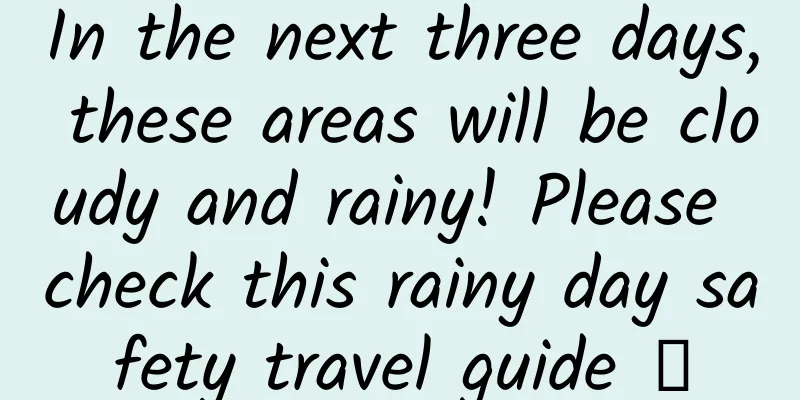In the next three days, these areas will be cloudy and rainy! Please check this rainy day safety travel guide →

|
The Central Meteorological Observatory predicts that in the next three days, it will be cloudy and rainy in the eastern part of the southwest region to the south of the Yangtze River. Specifically, there will be light to moderate rain in the eastern part of the southwest region, Jianghan, Jiangnan, Jianghuai, western and northern South China, among which there will be heavy rain in some parts of eastern Guizhou, central and western Hunan, and northern Guangxi. From 08:00 on February 19 to 08:00 on 20th , there will be light rain in parts of southeastern Tibet, eastern southwest China, southern Jianghan, most of Jiangnan, western South China, eastern Hainan Island, and eastern Taiwan Island. Among them, there will be moderate rain in some parts of eastern Guizhou and central Hunan. Image source: China National Meteorological Administration From 08:00 on February 20 to 08:00 on 21st , there will be light to moderate rain in parts of the eastern part of Southwest China, the southeastern part of Northwest China, Jianghan, Jianghuai, western Huanghuai, Jiangnan, northern and western South China, eastern Hainan Island, and Taiwan Island. Among them, there will be heavy rain (25-45 mm) in some parts of southeastern Guizhou, northern Guangxi, and western Hunan. Image source: China National Meteorological Administration From 08:00 on February 21 to 08:00 on February 22 , there will be light rain in parts of southeastern Tibet, eastern southwest China, Jianghan, northern and western Huanghuai, most of Jiangnan, and western South China. Among them, there will be moderate rain in southeastern Tibet, eastern Guizhou, southeastern Chongqing, and central and northern Hunan. Image source: China National Meteorological Administration Safety tips for rainy day travel ↓↓↓ (1) Rainy days are often accompanied by strong winds. You should try to avoid going out. If you need to go out, stay away from temporary buildings such as billboards and work sheds, and be careful of falling objects. (2) Do not let umbrellas or raincoats block your view forward to avoid collisions with other vehicles. (3) During a thunderstorm, do not walk in open areas, outdoors, or near pools, and do not make or receive phone calls outdoors. (4) When traveling on rainy days, be careful of deep potholes such as sewers and sewage wells. If you find whirlpools or springs on the road, be sure to detour. Also pay attention to special signs on the road. These may be signs that remind passers-by and vehicles to be careful after discovering dangerous situations. (5) If you are cycling, stay away from deep water and vehicles, and choose higher ground to ride slowly and safely. When cycling, do not let your raincoat block your vision or affect your hearing. If the road conditions are bad, it is best to push the bike and walk. (6) When driving in the rain, you must first maintain a clear field of vision and ensure that the wipers can work properly. If the windows are fogged up during driving, you can adjust the air outlet mode to defog and turn on the cold air conditioner to dispel the fog. You must pay special attention to pedestrians and bicycles on the road. When you encounter pedestrians, you should slow down in advance, honk the horn more often, and patiently avoid them. The roads are slippery in the rain, so you must reduce your speed and try to avoid sudden braking operations to prevent the vehicle from skidding out of control. When turning, it is often easy to skid, so you should drive slowly and return to normal speed after turning. Steering should be gentle and not too hard. (7) When you encounter a flooded road, you can first observe the water depth and use the same type of vehicle in front as a reference. If there is no reference, you can observe the water depth before wading. If the water level reaches two-thirds of the bumper or tire, it will be dangerous to drive through the water. You should try to bypass it and do not force your way through. When the car passes through a flooded area, it should be driven slowly to avoid splashing water into the engine. When driving in a flooded area, you cannot stop, change gears or release the accelerator in the middle of the journey. You should drive through at a low gear and at a constant speed. If the engine stalls while wading, it cannot be restarted. Comprehensive sources: Central Meteorological Observatory, China Meteorological Network, etc. Note: The cover image is a copyrighted image. Reprinting it may cause copyright disputes. |
>>: “Eating while it’s hot” may really cause cancer, so I advise you to stop immediately!
Recommend
It costs tens of thousands of yuan to "start up" the machine once. What are the advantages of surgical robots?
Review expert: Shi Yunlei, PhD, Department of Inf...
Hello, robot, I want to have a chat with you.
Can robots communicate emotionally with humans? W...
Be determined not to be a “lone swimmer”, please remember this knowledge!
The weather is hot in summer How to avoid drownin...
This article will guide you from 0 to 1 to build an overseas operation and promotion system!
How to build an overseas operation and promotion ...
iOS 19 leaks are here, and the first new feature is exposed!
Although the official version of iOS 18 has only ...
The body sends out signals when you are aging. Check yourself! The key to brain longevity is to look at…
Experts in this article: Wang Gang, Chief Physici...
Why do we need to seize node traffic?
The previous article said that "marketing is...
Was Einstein wrong? Einstein vs. Bohr: The EPR experiment
In order to explain the strange properties of qua...
9 major processes of Tik Tok live streaming, a must-have operating guide for beginners!
In our previous articles, we have shared many met...
How AI can help companies make better business decisions
How AI can help companies make better business de...
Are there "traps" on your computer desk? Beware of "mouse hand"!
1. What is “mouse hand”? "Mouse hand", ...
How can we deliver ads to users who are most likely to spend money?
Every advertiser has this hope: to get the greate...
Do you take tens of thousands of steps every day? These "foot exercises" are really not suitable for you
Author: Tang Qin, Deputy Secretary-General and Re...
Qualcomm and Samsung are preparing to ban MTK, and Snapdragon 835 is shipped at a low price to monopolize the high-end market
With the successive appearance of domestic flagsh...
How much does it cost to customize a furniture mini program in Xilingol League?
The factors affecting the quotation of Xilinguole...









